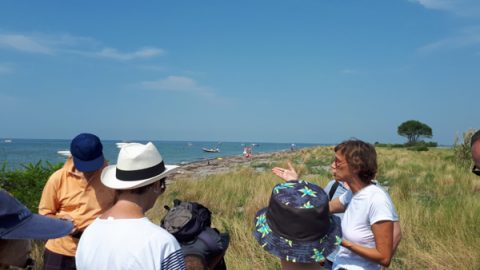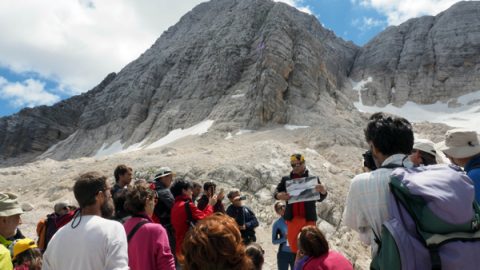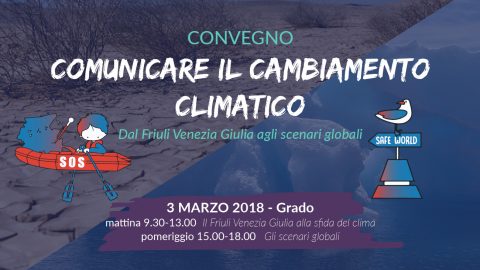Outreach and Communication
This site provides a compilation of projects that explore new ways to communicate the science and its consequences to the general public.
De Weerman podcast
The Podcast De Weerman is an attractive and popular format with an impressive community of followers. It is produced by the Dutch Public Broadcasting Association.
De Weerman is all
- about weather and climate,
- about the mechanisms behind weather phenomena,
- about weather forecasting and climate change.
It is addressing a general audience, no background in meteorology or science is needed. Each episode of the podcast is centered around a theme and the meteorological processes are explained in layman’s words in order to inform the general public on a more detailed level than possible in regular news and weather forecast items on TV and radio. The podcast is a mix of fun facts, science, impact, and the relation between climate and weather is woven into the episodes. The podcast is hosted by TV weather forecaster Peter Kuipers Munneke, who is also a polar researcher at the Utrecht University in The Netherlands, specializing in the climate of the polar regions and ice sheets, and news anchor Fleur Wallenburg and their team.
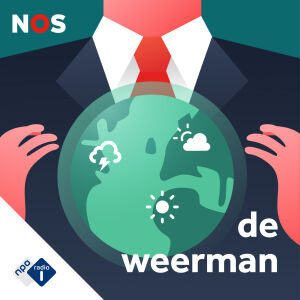
The podcast started in October 2019 and 30 episodes have been produced over a period of three years. The number of productions as well as the content and variety are continuously growing.
The Weerman is very useful to all parts of the society, because themes are flexible and deliver answers to many questions relating to weather and climate with the aim to inform in a colloquial and attractive manner. The pedagogical value through “voice-communication” draws attention to just the human “listening”-capability, requires and inspires fantasy of the listeners. It is a constant offer, guarantees continuity and seems to be institutional and attractive for listeners and so far timeless.
Mixture of a well-known TV-persons, and journalists guarantee a programme not overloaded with pure science and scientific language. Accessibility is easy, everyone with a computer or a mobile phone can choose their topic of interest and can repeat the programme as often as desired in order to better understand the content. Download enables the listener to collect the different editions and archive them for further use. The audience will get used to listen to climate issues.
The podcasts are professionally produced. The 30 episodes have been accessed over >300k times so far. The entire collection of podcast episodes can be found on Spotify, Apple Podcast, any other podcast browser, or online at https://www.nporadio1.nl/podcasts/de-weerman
ExtremeWeatherCongress
The ExtremeWeatherCongress, initiated in 2006 and taking place ever since, is a huge long-term effort with an extensive press-coverage and presence in media-channels, newspapers and social-networks to support widening the interest in conference topics. All public outreach is supplemented by comprehensive fact-sheets about the actual state of the climate in general and especially in Germany.
It is organized and moderated by Frank Böttcher.
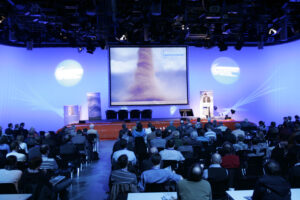
The conference is highly relevant: different groups of the society are involved (science, communication, politics, educators, media) – an important element is the involvement of schools, representing the future audience, potential students and scientists. The congress also became an important activity within schools: extension of trainings to schools is providing a broader audience and is going beyond traditional standard formats of just a congress event. Children are the future, so they will learn about the weather events and how to prevent and how to behave in such cases.
The ExtremeWeatherCongress has built a significant audience, both of media people and members of the public, over more than 15 years. It became a strong channel of communication about climate science with the aim to make climate research accessible to the public and media, for discussion. Since the launch of this congress in 2006 delegate numbers have increased from 400 to over 3,000 (offline and online).
Many of the congress speakers are outstanding climate communicators. The online content is excellently produced. This conference has benefitted from having a virtual presence so that it can reach wider audiences. Today (2022), the ExtremeWeatherCongress is the leading interdisciplinary specialist conference for extreme weather in climate change in Germany and, as a dialogue event between science and the public, makes an important contribution to climate communication.
Other trustworthy elements of the conference are: scientific cooperation with the German National Weather Service and cooperation with the German Climate Consortium, the German Meteorolgical Society (DMG) and Skywarn.
The program is an excellent mixture combining relevant topics of weather and climate change. Speaking of a great variety – reports from relevant events in the near environment but also touching the global perspective. Other relevant themes and sessions are about sustainability of companies, economic development, transfer to a more sustainable society, special programmes to achieve important goals, relevance and development of social-media, judgement of fake-news, communication of climate-change, newest results of scientific research, just to name a few.
- Information about the 2022 ExtremeWeatherCongress: https://ewk2022.de
The benefits of using TV meteorologists as climate change communicators
The main objective of the project “The benefits of using TV meteorologists as climate change communicators”, established by the Norwegian Meteorological Institute (MET Norway), is to integrate research-based climate material into weather presentations so that members of the public are informed and engaged about human-caused climate change.
By educating and using TV meteorologists as climate communicators, MET Norway reaches a large part of the population through well-established channels. In this way knowledge about climate change is brought closer to people’s everyday lives and their experience of the weather so that connections between weather and climate become clearer to the public. This project is a good example of what can be achieved when scientists, meteorologists, designers and communication advisors work closely together.
A key to engagement is to provide a local angle to the often abstract and global phenomenon of climate change. The project team believes it is important to link knowledge about climate change to people’s everyday lives and their experience of the weather. The project was launched in 2019 and has since produced 40 climate stories on the national TV-news. These news stories have covered temperature changes, Arctic sea-ice, flash-floods, and changes in snow cover. The stories are also shared through social media and press releases to reach beyond TV and radio users. The TV meteorologists have included climate communication in their weather forecasts, and were also interviewed live by the news hosts in the studio. Climate change has become a natural part of the weather conversation on TV, radio and social media. Good, visual products have been developed to make the message more accessible for the audience. All these initiatives have resulted in enhanced coverage of climate issues.
The project team is composed of:
- TV meteorologists Kristian Gislefoss, Rafael Escobar Løvdahl and Bente Wahl;
- Climate researchers Hans Olav Hygen, Ketil Isaksen and Gunnar Livik;
- Communication experts Mai-Linn Finstad Svehagen, Anniken Celine Berger, Amalie Kvame Holm and Anders D. Sivle.
At MET Norway, the project owner is Oddvar Paulsen, Director of the Organisation and Communication Department. Day-to-day management of the project was shared between the Forecasting Department (A. Sivle) and the Communication Department (A. Berger & A. Holm). The project was funded by the Research Council of Norway.
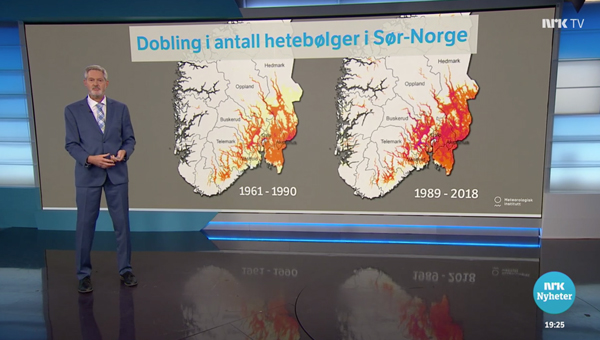
Comunicare il cambiamento climatico: public outreach project
With the project “Communicating Climate Change” (“Comunicare il cambiamento climatico”) the Italian environmental NGO Legambiente FVG (the Friuli Venezia Giulia branch of the organisation) tried to answer questions like:
- What is the best way to communicate climate change?

- How can we make people aware of the need to act before it is too late?
- Why is it so difficult to get governments involved in taking action against climate change?
The project consisted of conferences, guided tours, a school competition, video-making, etc. Activities took place from April 2017 to March 2018 in different places in the region and involved scientists, environmental activists, journalists, writers, teachers, students, experts, migrants and, generally, citizens.
“Comunicare il cambiamento climatico” was coordinated by the journalist and writer Elisa Cozzarini.
As an output of the project, a playlist of ten short documentaries, was produced and made freely available with English subtitles:
The documentaries are also available on demand with Slovenian subtitles.
The project Comunicare il cambiamento climatico received the EMS Outreach and Communication Award in 2019 for raising awareness of the effects and impacts of climate change in the Friuli Venezia Giulia region.
The Magazine ”Vejret” from the Danish Meteorological Society (DaMS)
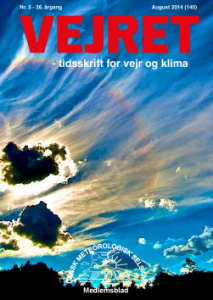 “Vejret” has existed since 1979, but has constantly renewed itself in the pursuit of promoting the understanding of the weather, climate and meteorology among the broader population. “Vejret” is the main reason for the popularity of the Danish Meteorological Society, which has one of the highest membership numbers, relative to the size of the population, in Europe.
“Vejret” has existed since 1979, but has constantly renewed itself in the pursuit of promoting the understanding of the weather, climate and meteorology among the broader population. “Vejret” is the main reason for the popularity of the Danish Meteorological Society, which has one of the highest membership numbers, relative to the size of the population, in Europe.
The Chief editor, John Cappelen, and the editorial staff on one hand ensure that articles from experts are edited so that they are readable also to the many non-experts in the society; on the other hand articles from everyday weather enthusiasts are edited to ensure that they are scientifically correct. The maintenance of this balance is what ensures the popularity of the magazine.
- Vejret home page: http://dams.dk/vejret/index.html
Come Rain or Shine: Online course
The Royal Meteorological Society partnered with the University of Reading to develop this three week course which focusses on the processes and phenomena which govern UK weather. The content of the course was developed with the needs of UK secondary geography teachers in mind, however the course was open and very much of interest to all.
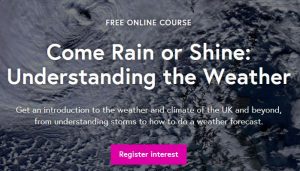 The free online course, available via FutureLearn, was created with the aim of training geography teachers in basic weather and climate processes, in order to teach their pupils the national curriculum. Since it launched in 2016 it has been taken by more than 23,000 members of the public, including students and teachers who have left comments online stating how useful it has been as a resource in the classroom.
The free online course, available via FutureLearn, was created with the aim of training geography teachers in basic weather and climate processes, in order to teach their pupils the national curriculum. Since it launched in 2016 it has been taken by more than 23,000 members of the public, including students and teachers who have left comments online stating how useful it has been as a resource in the classroom.
Come Rain or Shine covers topics like weather charts, the physical processes that cause weather and how to use weather measuring equipment. Course content includes videos, fieldwork activities and other practical exercises, written by Dr Peter Inness from the University’s Department of Meteorology, and Dr Sylvia Knight, Head of Education at the Royal Meteorological Society.
The free course runs about three times each year. It requires around three hours of flexible study time per week over a three-week period, or longer if required. It is supported by Ph.D Meteorology students at the University, who provide online mentoring to participants.
FutureLearn is a leading Massive Open Online Course (MOOC) platform delivering online learning to participants around the world, free of charge. Running a course on this platform has been a key way for the University to engage new and harder-to-reach audiences, and to develop course content that is interactive and engaging.
Online information on the course
- Come Rain or Shine https://www.futurelearn.com/courses/come-rain-or-shine/
The online course Come Rain or Shine has been selected to receive the EMS Outreach and Communication Award in 2018 for its outstanding outreach and sustainability.
Le train du climat & ses messagers
The project
 Taking place on the eve of the Paris accord negotiations in 2015, the project “Le train du climat” has been very successful and has met its main goal, which was to advance climate literacy and to contribute to science-based policy making and individual actions, by raising public awareness and delivering a nationwide message about climate change.
Taking place on the eve of the Paris accord negotiations in 2015, the project “Le train du climat” has been very successful and has met its main goal, which was to advance climate literacy and to contribute to science-based policy making and individual actions, by raising public awareness and delivering a nationwide message about climate change.
 The exhibition has been built as a narrative story using a combination of state of the art outreach methods to educate the public. On its 3-week journey around France and 19 stopover cities in total, the train reached 23,000 people plus ~3000 school children and ~1000 decision makers and elected representatives. It also received an extensive coverage in media, which included TV, radio and news papers.
The exhibition has been built as a narrative story using a combination of state of the art outreach methods to educate the public. On its 3-week journey around France and 19 stopover cities in total, the train reached 23,000 people plus ~3000 school children and ~1000 decision makers and elected representatives. It also received an extensive coverage in media, which included TV, radio and news papers.
The idea of a train-based outreach tool for climate has been taken up in 2016 by Morocco for COP22 in Marrakesh and a new edition of Le train du climat is planned in France again in 2017-2019 with a special focus on solutions at regional scale.
Co-initiators of the project
 The project was collectively devised by Christophe Cassou, Research scientist at CNRS/Cerfacs (Centre National de Recherche Scientifique), Catherine Jeandel, Research Director at CNRS, Beatrice Korc, a free-lance editorial manager, and Serge Planton, a Climate Researcher at Météo-France. 42 scientists of very diverse expertise from 13 different institutes were on board. The project was strongly supported by SNCF, the French National Railway Company, and Train-Expos, its subsidiary, together with the ministries of Education & Research and Ecology (all photos by “Messagers du Climat”).
The project was collectively devised by Christophe Cassou, Research scientist at CNRS/Cerfacs (Centre National de Recherche Scientifique), Catherine Jeandel, Research Director at CNRS, Beatrice Korc, a free-lance editorial manager, and Serge Planton, a Climate Researcher at Météo-France. 42 scientists of very diverse expertise from 13 different institutes were on board. The project was strongly supported by SNCF, the French National Railway Company, and Train-Expos, its subsidiary, together with the ministries of Education & Research and Ecology (all photos by “Messagers du Climat”).
A very detailed account of the project from its first ideas to the practicalities of its implementation, its achievements and lessons as a building process along its journey, the wealth of other activities that had been instigated on its way through France, is given in the proposal that was submitted for the EMS Outreach & Communication Award:
Success factor
“Le train du climat” has been selected to receive the award for its very innovative and original concept to develop an exhibition on a train, as a catalyst for discussion and debate about climate change issues, between scientists and cultural mediators present on board and general public.
Sandscape
The Project
 Budding sand sculptors were shown how to fashion elaborate structures from sand and water – creating a landscape with bridges, towers, factories and even stadiums. As they worked they reflected on what makes a healthy city, discussing with the scientists how the natural and built environments influence air quality and circulation and how this impacts our health.
Budding sand sculptors were shown how to fashion elaborate structures from sand and water – creating a landscape with bridges, towers, factories and even stadiums. As they worked they reflected on what makes a healthy city, discussing with the scientists how the natural and built environments influence air quality and circulation and how this impacts our health.
Sandscape – links to further information:
- Sandscape – the project (includes overview video)
- Sandscape at Arts by the Sea
Success factor
The Sandscape project received an Honourable Mention for its innovative, clever, interactive and visually stimulating approach, which combines hands-on demonstrations, entertainment and plenty of fun in order to increase public interest and awareness.
Science Park of the Austrian Central Institute for Meteorology and Geodynamics
The Project
The main aim of the Science Park of ZAMG is to offer a state-of the-art science communication (hands-on, minds-on) in the areas of weather, climate, environment and geophysics at ZAMG’s head quarter in Vienna and at the Customer Service Offices (Salzburg, Innsbruck, Klagenfurt, Graz).
The objectives of the concept include
- To address people of all ages, who visit the ZAMG with guided tours, or during special events;
- To motivate visitors to participate in ZAMG´s science projects that have a Citizen Science approach (e.g. severe weather, phenology and climate, change, reports of earthquakes, etc.);
- To encourage to reflect and discuss the connections between science and everyone´s life and the possibilities of interacting;
- To intertwine the official measurement sites and the route of the guided tours.
The Science Park at the ZAMG head quarters opened on 23 March 2015, World Meteorological Day; the Science Parks in Graz and Salzburg opened in 2016, also on World Meteorological Day (23 March 2016).
6000 people have visited the Science Park until mid-2016r, 4000 on giuded tours, 2000 during the Austrian “Night of Science”.
More information on the Science Park:
- Insights into the ZAMG Science Park: Short video on YouTube (duration 1:20 minutes)
- Album on flickr
- Article on the Opening and Concept of the Science Park (in German)
UK Festival of Weather, Arts and Music
The Project
Founded in 2012 by Pierrette Thomet Stott, the Festival of Weather, Arts and Music (WAM) has found new ways to communicate the beauty and fascination of meteorology thereby enhancing the understanding of weather and climate science by the general public in the United Kingdom. This outstanding initiative has broadened the reach of scientific meteorology, enabled the general public to engage with meteorology in novel ways and enhanced many people’s appreciation of its effects on our lives and the challenges involved in forecasting it. The list of innovative approaches combining arts and meteorology is long.
Since its foundation in 2012, WAM has held three very successful events. The first festival in 2012 saw about a thousand people take part in a wide variety of events in Reading Town Hall. These included a weather fair, music recitals, a Climate Change Question Time, an art exhibition, a weather clinic, and a recreation of Lewis Fry Richardson’s Forecast Factory.
Pierrette Thomet Stott, the WAM Director, said: “I am absolutely delighted to find WAM has found this recognition in European circles, and I am deeply honoured by this award.”
About Pierrette Thomet Stott: She holds a BA in Music from the University of Reading and a Diploma in Operatic Performance from the University of London. She trained as a mezzo-soprano and has performed in Great Britain and abroad as a recitalist and oratorio soloist as well as having many years’ experience teaching singing. In 2011 Pierrette devised the idea for a festival bringing together the arts and meteorology/climate science, to promote Reading as a centre of excellence in both fields and explore the possibilities inherent in bringing these different disciplines to interact. Since the first WAM Festival she has led the development of WAM through the RMetS WAM Special Interest Group, which she chairs.
More information on WAM events:
Trusted Spotter Network Austria
The Project
TSN-Trusted Spotter Network Austria (www.zamg.ac.at/tsn) was established to build up a reliable network between spotters (chasers), operational forecasters and scientists. TSN in its current state constitutes the collaboration between the Austrian meteorological service ZAMG (www.zamg.ac.at), SKYWARN AUSTRIA including its various partner organisations and the European Severe Storms Laboratory ESSL with its European Severe Weather Database ESWD. METEOPICS as a further network partner (www.meteopics.eu) provides a public forum for images of severe weather and damage surveys.
In principle, a “trusted spotter” reports significant or severe weather and consecutive damages. The technical solution is constructed around a server as Single Point of Contact to distribute reports according to the needs of different collaborators of SKYWARN. The reports are displayed for ZAMG forecasters in nearly real time via the ESWD platform, and are also accessible for the open public, respectively.
Basically, the Trusted Spotter Network is also open for other spotter groups, organisations and individuals willing to contribute reports within the framework.
With TSN the reliability of the information for operational forecasters has been improved significantly. ZAMG offers an individual training program, regular workshops as well as constant professional and scientific support.
In this respect, TSN seems to be unique among European national weather services.
One branch of the individual training consists of job-shadowing, which is obligatory at least once for each individual TSN member. This part is provided personally by forecasters of every regional centre of ZAMG in Austria and follows a standardised procedure. Here, the focus concentrates on the understanding and practical application of the respective event types according to the ESWD standards.
The second part of the training is the individual attendance of the annual workshop which is usually held at ZAMG Vienna during the early months of the year. In addition to scientific presentations by ZAMG staff, all participants are given the opportunity to present their own case studies and discuss meteorological phenomena in detail. This workshop is also open for a larger group of interested persons outside of the network who wish to contribute to the scientific discussion.
Milestones and summary
The role of TSN Austria is unique among similar cooperations in Europe; no other weather service takes such comprehensive steps regarding training, support and cooperation with spotter organisations. All regional centers of ZAMG are involved in the training and scientific support of spotters and chasers. TSN provides retraceable, documented reports with high quality clearance (tsn.meteopics, ESWD).
Thoroughly quality controlled reports of severe weather cases are available to weather services, scientists and the interested community in near real time.
Beneficiaries from the TSN activity:
- The Austrian Weather Service ZAMG with all its regional centers, forecasting, warning, climatology and science,
- The general public via more reliable and “just in time” severe weather reports and warnings,
- Austrian civil authorities, disaster management and the Austrian aviation weather service,
- The ESWD data base,
- European insurance companies,
- Public media, and
- last but not least, the spotter organisation SKYWARN via expert support and attendance from its partners.
Success factors
The TSN network provides a win-win scenario for all involved partners:
The spotters and chasers receive intensified scientific and technical support to improve their knowledge.
The forecasters benefit directly from the real time information about hazardous weather situations and are able to refine forecasts and warnings, respectively. Also the continuous discussion and feedback process with individual spotters is valuable and informative for forecasters and improves their awareness.
The activity of the spotters can be instantly distributed to the public via different kinds of media.
The ESWD database and therefore the scientific community are benefiting from reports with higher reliability and quality standards.
Recommendation
TSN could be a European role model for other weather services either to establish or to intensify their respective dialog and engagement with national spotter organisations. ESSL/ESWD recommends this model to other European partners.
The number of spotters in Austria is growing at a continuous rate which results in higher spatial density of potential extreme weather observers. Cuts in budget among all European national weather services bring new weight on additional “cloud” information retrieval from weather amateurs and semi-professional spotter groups. In this respect the network represents a huge advantage for ZAMG and the general public.
The aim of such an intense collaboration could be a consistent coverage of severe weather reports with a comprehensible quality control and standardised criteria. This information is already publicly available to everyone via the open database ESWD.
In this respect a clear scientific analysis of the trend of the occurrence of severe and catastrophic weather events lies a bit more within reach.
For example: First investigations show that all (100%) strong precipitation events of the last four years in Austria have been identified and reported by the Trusted Spotter Network and are on display on ESWD. Hit rates for other meteorological parameters like hail or downbursts are constantly rising.
References
http://www.essl.org/ECSS/2011/programme/abstracts/137.pdf
http://www.essl.org/ECSS/2011/programme/posters/137.pdf [1.9 MB]
Media Clippings ARTE (French, German): http://www.youtube.com/watch?v=5MwX5_o4wss
“Turbulence” Programme on Česká televize
The Project
This project is essentially about outreach and communication. Engaging meteorologists/weather presenters and communicating weather and climate issues through TV programmes is particularly powerful. This approach has the potential to really reach an wide spectrum of ages and education levels of the population, and it had quite a broad audience.
The programme communicates weather, weather phenomena, climate and hydrology to the general public also explaining these phenomena; it therefore has the potential to educate a wide audience in a pleasant and attractive way, discussing and explaining the weather of the previous week around the world. The project then communicated further with the audience through a website and Facebook site that are currently still alive.
- The “Turbulence” Programme on Česká televize won the EMS Outreach & Communication Award in 2014
Success factors
The most recent findings which are currently lacking in the educational system like climate change, weather phenomena in the context of different parts of the world, the role of the ocean in the Earth’s current climate, hydrological cycle etc. were the main themes for which the programme received a rating of 1,5%, i.e.twice more than the mean of the news channel. The market share has reached 6,9 %. In a country where the climatescepticism is widespread, this was the only original television project, informing about the problems of weather and climate in an unbiased manner and it became quite popular among people.
Recommendation
“Personalities familiar to the viewers from television weather forecasts should explain the nature of the formation of phenomena and clarify the connection between phenomena.
Really specific is the editor communication with the audience. In addition to the normal procedures of correspondence and contacts through a specialised site: www.turbulencect.cz where viewers could put questions, suggestions and comments including pictures, a very active and individual communication through the social network Facebook was developed. The specialised page Turbulence became the basis for the successful weather site Počasí ČT (Weather in Czech Television) https://www.facebook.com/pocasict, which now has more than 17,000 supporters and is growing daily.”
The UK MetOffice STEM Outreach Programme
The UK MetOffice STEM Outreach Programme won the EMS Outreach & Communication Award 2014.
The Programme
The Science, technology, engineering and mathematics (STEM) programme is a very substantial and comprehensive outreach effort, sophisticated and ambitious. It uses many tools to reach out to both children and adults and communicates the joy of science, e.g. science camp, attendance at science fairs and last but not least with ambassadors. Some of the elements are also hands on, which is time consuming but can be so rewarding.
Particularly noteworthy also is the ‘open house’ experience where youngsters can meet the Met Office and sea and learn what is going on. The STEM Outreach Programme is great for building role models and putting a face on science, in addition to learning the science. This year’s World Meteorology Day theme was “Weather and Climate: Engaging Youth,” and the MetOffice’s STEM Outreach Programme is very relevant also from this point of view.
Success factors
Delivery of our STEM Outreach programme is built into our Corporate Plan, with the number of STEM activities undertaken each year reflected as a business performance measure and a target we have exceeded in each year since its inclusion. We also evaluate the delivery of our major STEM activities, such as Met Office Science Camp. Our aim is that by the end of summer 2017, more than 1000 students will have attended a Met Office Science Camp and left us informed, inspired and just a little bit tired!
Recommendation
“Science, technology, engineering and mathematics (STEM) are at the heart of the Met Office. Consequently, we are continually looking at ways to engage young people in the fascinating worlds of weather and climate. The Met Office STEM Outreach and Ambassador scheme is fully endorsed by the Met Office Executive Committee and staff are encouraged to deliver STEM activities within their day-to-day work. All of our 170+ Met Office STEM Ambassadors are registered on the national STEMNET scheme (www.stemnet.org.uk). By tapping into this existing scheme rather than administrating its own programme, the Met Office benefits from the mechanisms already in place to support Ambassadors – from the arrangement of the Disclosure and Barring Service checks; the training and other continuous professional development on offer; to contacts into schools and notification of national STEM events. As well as the extensive benefits to young people, STEM outreach gives staff volunteers huge satisfaction and pride, an effect that lasts beyond a given event, and an opportunity to get involved in something different to ‘the day job’.”
theWeather
![]() The magazine of theWeather Club, won the EMS Outreach & Communication Award in 2011.
The magazine of theWeather Club, won the EMS Outreach & Communication Award in 2011.
theWeather Club, which launched in September 2010, is the public outreach arm of the UK’s Royal Meteorological Society. theWeather Club aims to inform and educate whilst also encouraging people to participate and pursue an interest in meteorology. To achieve these aims it is necessary to communicate the science of meteorology in a non-technical and interesting way.
theWeather Club’s charitable objectives are achieved by offering a series of membership benefits including the quarterly issue of a superb magazine, theWeather, a free Galileo thermometer, exclusive web access, and other discounts and collectables. The target audience is for anyone with an interest in the weather and the content is presented in a non-technical style.
One of the key membership benefits is a popular quarterly publication called theWeather. Its content reflects the many faces of the weather – its beauty, its power, its occasional absurdity and its fragility in the face of human activity. With an international news digest and a range of features covering areas as diverse as science, culture, sport, politics, food, gardening, leisure and history, theWeather magazine offers proof of just how deep and fundamental the influence of the weather is upon us all.
The magazine and website include regular news items; features on weather and climate; regular columns; and stunning photography. The content is written in a popular style to explain the science behind weather and climate. theWeather magazine is beautiful to look at, and with its thick, high grade, 100% recycled paper, has a pleasing feel to match its environmental credentials.
To complement theWeather, the website provides extra content and opportunities for members to participate in weather debates and discussions, join forums, post views, propose ideas, submit images and share weather observations.
Success factor
theWeather presents a novel and exciting way of communicating the science of meteorology and its impact on society to a general public. It relates weather to common activities and subjects such as culture, sport, politics, food, gardening, leisure and history and in this way tackle the challenges to bring the science of meteorology into the realm of people’s daily life.
Recommendation
The timeliness and importance of the theWeather Club’s attempt to tackle the difficult subject of the interface between climate and weather can not be appreciated enough – this is a crucial issue in communicating climate change to any non-scientific audience.
The photographic material is impressive and creates interest and awareness in weather and climate topics, stimulating a broad audience to enjoy the known’s and unknown’s within the science of meteorology.
Mountain Wave Project
The MWP won the EMS Outreach & Communication Award in 2011.
Is it possible to fly a distance of 2.000km (i.e. Zurich – Casablanca) with a modern glider in one day only using atmospheric currents and updrafts? What role does the jet stream play, how strong is the turbulence and the vertical momentum transport in the stratosphere? The Mountain Wave Project (MWP), a non-profit initiative of the Scientific and Meteorological Section of the Organisation Scientifique et Technique Internationale du Vol à Voile (OSTIV) has been researching such topics for several years by studying aviation-relevant atmospheric flow patterns together with state-of-the art aviation weather forecasting and its application on high performance flying, as well as aviation safety in general.
The MWP being a scientific project focused on applications, deserves great merit for incorporating outreach activities as part of the project . The communication with the public uses a variety of different channels explaining the issues to a wider audience.
Success factor
Through TV-features, radio broadcasts, publications, posters and numerous articles in the print media, the MWP regularly draws attention to atmospheric phenomena relevant for ozone depletion, momentum and pollution transport from the troposphere into the stratosphere, improvement of the parameterization schemes used in numerical weather and climate models, space weather and dispersion models.
The concept of the Mountain Wave Project TV-documentary “Rodeo in the Sky – research for greater flight safety” is thrilling, moving, and educational, a very original and unusual combination.
Meteo Weekend - weekly TV programme combining forecast and science
The Project
The mcombination of forecast and science is a good vehicle to educate the general public about the atmospheric science, the way to use the weather forecasts, and an open window towards several science fields and a good knowledge on the environment. The format is limited to a studio discussion and a graphic display of weather charts and graphs on a flat panel monitor in the TV studio. This programme represents a solid attempt to draw the awareness of the general public to the science behind weather forecasting.
The innovative content of such a programme is the combination of the scientific information on meteorology with a classical weather forecast. It also builds on the fact that weather forecasts, in particular on the weekends, raise considerable interest and warrant a large audience and a very good share, about 180.000/300.000 people every Friday evening and Saturday morning (Friuli Venezia Giulia has 1.200.000 inhabitants).
Success factor
The viewer appreciates the completeness of the weather forecast for the region, the macro-region Triveneto and the neigbour countries of Slovenia and Carinthia, The selection of the weekly topic and its connection with the local territory, The high-qualified guests and the easy but effective speech used.
Recommendation
“In Italy Meteo Weekend is the only broadcast in prime time (start at 20.30 – lenght 30 minutes) completely dedicated to meteorological and climatological topics, a demonstration that people don’t watch TV only for entertainment but appreciate scientific and tecnical subjects.” Marco Virgilio, MeteoWeekend.
Meteoalarm.eu - alerting Europe for extreme weather
The Project
The meteoalarm.eu website was designed to make the European general public aware of severe weather across Europe and enable them to take mitigating action in the advent of dangerous or high impact weather.
- meteoalarm.eu won the EMS Outreach & Communication Award in 2008
Phenomena include strong winds, heavy rain, fog, forest fire risks, avalanches and storm surges. The meteoalarm concept is based on assessing impact and damage. Thus awareness levels are assigned in a coherent and consistent way all over Europe, down to the regional and departmental scale. For example a 10 cm snowfall event in the Low Countries will trigger an orange alert, while the same amount in Alpine regions will only cause a green or perhaps yellow awareness level. The National Weather Services coordinated in EUMETNET assemble their most detailed weather alerts on this platform. The warnings are available in 28 languages.
Success factors
At its one-year anniversary on 23 March 2008, the site counted almost 3 million unique visitors, amounting to 500 million of hits.
Recommendation
“www.meteoalarm.eu informs successfully people worldwide about weather hazards in Europe because the system provides up to date information which is not to be found on any other platform. Targeted and well harmonized hazard information across Europe differs very much from general weather reports and helps to minimize risks for travellers and people working abroad. With a straightforward 4-level colour scheme hazards for 10 different hazard types are made very easily understood.” Michael Staudinger, ZAMG, Austria.
Ekstremværuka - One week of extreme weather information
The Project
The Extreme Weather Week is the most extensive popular scientific effort undertaken in Norway. In just one week, NRK broadcasts 125 TV programmes and more than 200 radio programmes focusing wholly or partially on weather and climate. The issue is also in focus on websites, teletext, WAP, DAB radio and jukebox TV during this period.
- The Extreme Weather Week won the EMS Outreach & Communication Award in 2008.
The project also spawned inniatives to actively involve schools and the general public; an outstanding example is the Rain Check.
Ekstremværuka is a co-operative effort by the Norwegian Broadcasting Corporation, the Norwegian Directorate for Education and Training, the Norwegian Meteorological Institute and the Bjerknes Centre for Climate Research (Video, 140 MB).
Success factors
The Extreme Weather Week contributed to increased awareness about an intriguing and important issue for society as a whole through a finely tuned mix of serious and entertaining programmes. Twinning the professional knowledge from scientists with journalistic skills and the distribution network helps meet the public need for sound knowledge about weather and climate.
Recommendation
“Climate change is one of the most important issues in our time. Through the Extreme weather week NRK has tried to contribute to a deeper understanding of what’s going on. The philosophy of the “Extreme weather week” has been based on the fact that most people have a need for new information on a subject they already know something about, like weather and climate. People have a lot of questions. Media can, in cooperation with scientists, contribute to give the audience more and better answers.
Our guidelines have been: Keep it simple, be creative and playful in the approach. Even if the perspectives might be depressive, don’t fall into depression. Give the audience a chance to take part in a process. Very often this will lead to a deeper understanding and a stronger commitment.“ Svein Haaland, Project Leader, NRK, Norway.
Saptamâna de vreme - Weekly weather
The Project
Saptamâna de vreme is a weekly weather and climate TV-show in Romania, the first and only one of its kind in this country. Since September 2005 it has been broadcast on the Realitatea TV news channel every Sunday at 6:45 pm for 30 minutes. The broadcast aims to communicate the science of meteorology, climatology and related phenomena in an appealing way to the general public. It also advises people on how to live in harmony with the weather and keep the environment clean and safe.
Emphasis is put on the most representative weather events in Romania or abroad, and the “secrets” of various meteorological phenomena are unveiled to the public. Answers to simple but important questions related to atmospheric phenomena are provided by two meteorologists and sometimes by invited specialists.
Success factors
The rating of “Saptamâna de vreme” reached 2.6 while the TV news channel that broadcasts the show has an average of 0.7 rating points. The audience measurements show a market share over 3.5.
Recommendation
“Our guidelines are: the programme has to answer simple but important questions, the topics of discussion have to be closely related to actual and current weather and climate phenomena and should also include those aspects that are directly linked to everyday life, the issues – regardless of their complexity – should be approached in an easily understandable way, and discussions should be visually supported by images, pictures, movies, charts,etc.” Elena Cordoneanu and the Saptamâna de vreme team, Realitatea TV.
MeteoX.com - Weather information within a blink of the eye
The MeteoX.com website provides real time images of clouds, rain fall, temperature and wind directions. The aim of the MeteoX.com website is to allow end users, both private and professional, to obtain real-time European weather data for free, enabling end users to take informed decisions on what the current weather does mean for them on the short term.
Actual radar data as front-end of the website provide an easy access point for the general public, from which users are lead to forecast results of modern weather prediction systems. This appears to stimulate the use of forecasts in daily practices and to raise the general interest for weather forecasting as a science, resulting in a more motivated way of looking at weather and climate conditions.
Success factor
In a short time MeteoX.com became the second-most visited weather information site in The Netherlands and is now expanding rapidly across the European continent. In Scandinavia, www.väderradar.se (i.e. Weatherradar) was launched.
Recommendation
“With the internet becoming more and more easily accessible for people, weather information can be provided locally and real time. On www.MeteoX.com you can see the “Here & Now” of the weather acoss Europe. This information is available within just 1 or 2 clicks which is one of the success factors of MeteoX.com. Another item contributing to this success is that all the real-time weather information is provided for free to the public.” Wijnand Rijkaart, Buienradar BV.


